Learning and Assessment in Education & Training: A Detailed Report
VerifiedAdded on 2023/06/09
|28
|9236
|449
Report
AI Summary
This report provides a comprehensive analysis of learning and assessment within the context of education and training. It delves into the roles and responsibilities of educators, emphasizing effective teaching methods, adherence to legislation and regulatory requirements, and the importance of maintaining professional boundaries. The report highlights the significance of identifying and meeting individual learner needs through initial and diagnostic assessments, and it details the creation of inclusive learning environments. Various assessment methods are explored, along with the use of feedback and recording outcomes. Furthermore, the report examines the effectiveness of teaching approaches, communication methods, and resources in meeting learner needs, while also addressing equality and diversity. Finally, it includes a review of personal practice in planning, delivering, and assessing inclusive teaching and learning, identifying areas for improvement. Desklib provides access to this and other solved assignments.
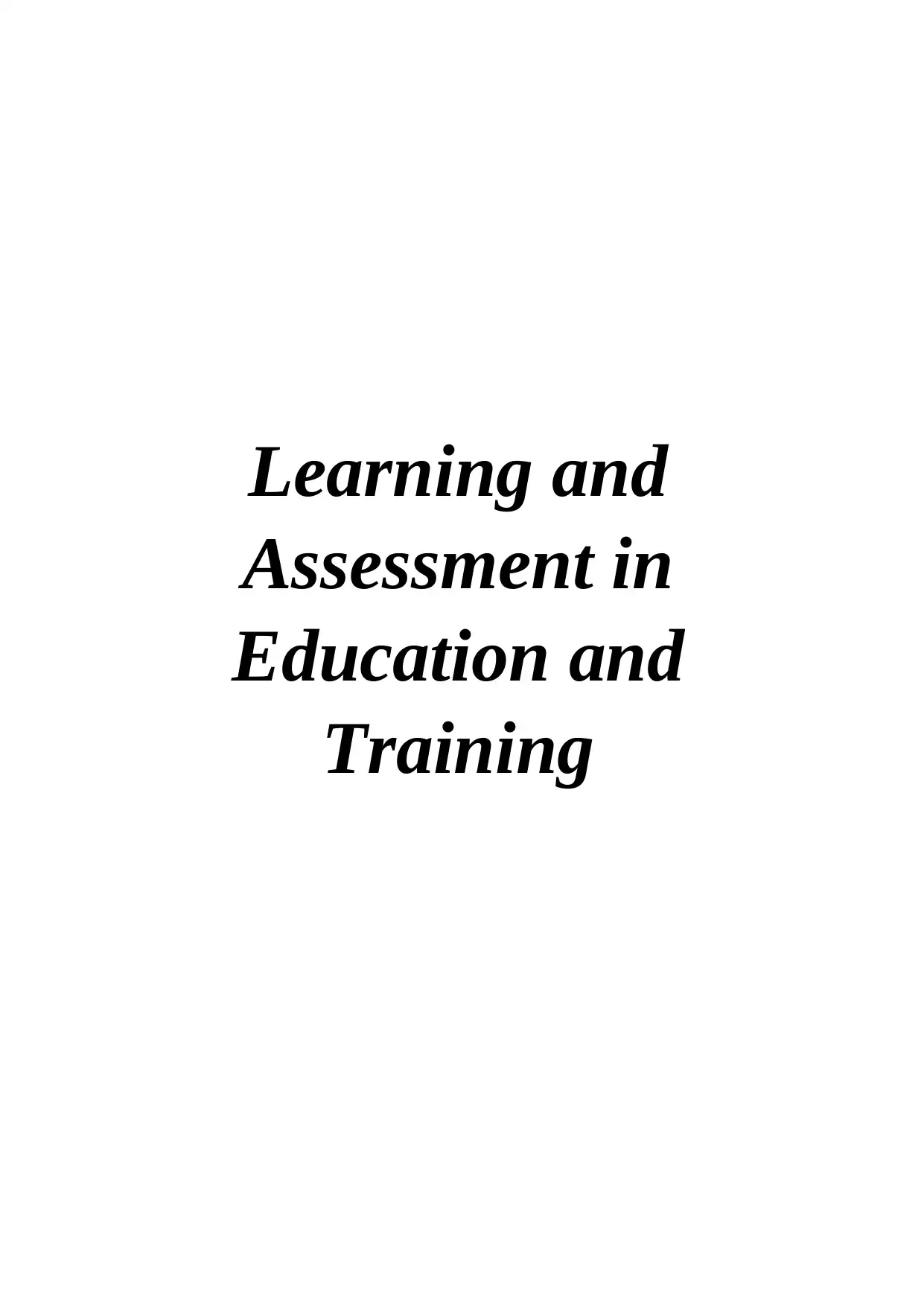
Learning and
Assessment in
Education and
Training
Assessment in
Education and
Training
Paraphrase This Document
Need a fresh take? Get an instant paraphrase of this document with our AI Paraphraser
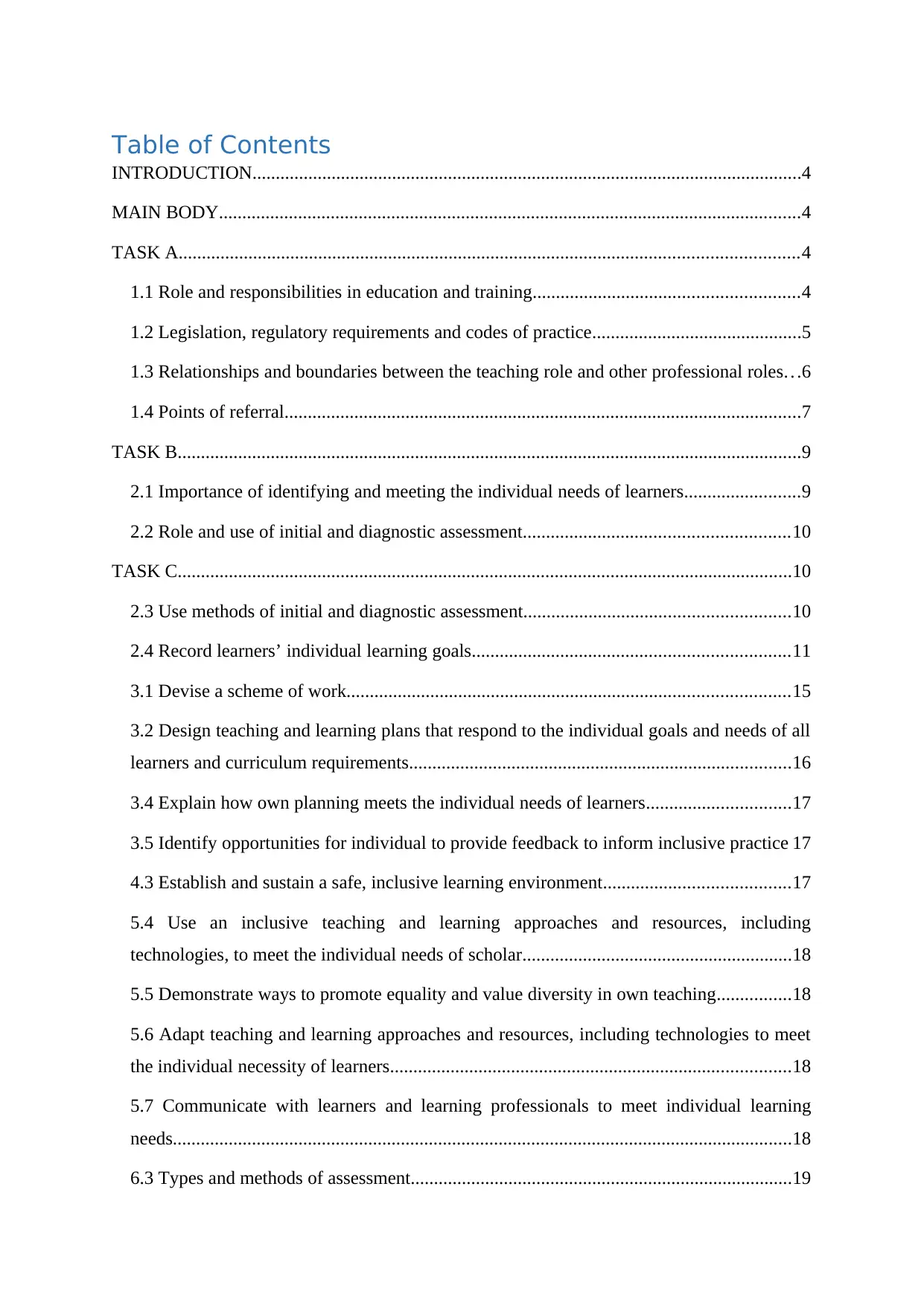
Table of Contents
INTRODUCTION......................................................................................................................4
MAIN BODY.............................................................................................................................4
TASK A.....................................................................................................................................4
1.1 Role and responsibilities in education and training.........................................................4
1.2 Legislation, regulatory requirements and codes of practice.............................................5
1.3 Relationships and boundaries between the teaching role and other professional roles. . .6
1.4 Points of referral...............................................................................................................7
TASK B......................................................................................................................................9
2.1 Importance of identifying and meeting the individual needs of learners.........................9
2.2 Role and use of initial and diagnostic assessment.........................................................10
TASK C....................................................................................................................................10
2.3 Use methods of initial and diagnostic assessment.........................................................10
2.4 Record learners’ individual learning goals....................................................................11
3.1 Devise a scheme of work...............................................................................................15
3.2 Design teaching and learning plans that respond to the individual goals and needs of all
learners and curriculum requirements..................................................................................16
3.4 Explain how own planning meets the individual needs of learners...............................17
3.5 Identify opportunities for individual to provide feedback to inform inclusive practice 17
4.3 Establish and sustain a safe, inclusive learning environment........................................17
5.4 Use an inclusive teaching and learning approaches and resources, including
technologies, to meet the individual needs of scholar..........................................................18
5.5 Demonstrate ways to promote equality and value diversity in own teaching................18
5.6 Adapt teaching and learning approaches and resources, including technologies to meet
the individual necessity of learners......................................................................................18
5.7 Communicate with learners and learning professionals to meet individual learning
needs.....................................................................................................................................18
6.3 Types and methods of assessment..................................................................................19
INTRODUCTION......................................................................................................................4
MAIN BODY.............................................................................................................................4
TASK A.....................................................................................................................................4
1.1 Role and responsibilities in education and training.........................................................4
1.2 Legislation, regulatory requirements and codes of practice.............................................5
1.3 Relationships and boundaries between the teaching role and other professional roles. . .6
1.4 Points of referral...............................................................................................................7
TASK B......................................................................................................................................9
2.1 Importance of identifying and meeting the individual needs of learners.........................9
2.2 Role and use of initial and diagnostic assessment.........................................................10
TASK C....................................................................................................................................10
2.3 Use methods of initial and diagnostic assessment.........................................................10
2.4 Record learners’ individual learning goals....................................................................11
3.1 Devise a scheme of work...............................................................................................15
3.2 Design teaching and learning plans that respond to the individual goals and needs of all
learners and curriculum requirements..................................................................................16
3.4 Explain how own planning meets the individual needs of learners...............................17
3.5 Identify opportunities for individual to provide feedback to inform inclusive practice 17
4.3 Establish and sustain a safe, inclusive learning environment........................................17
5.4 Use an inclusive teaching and learning approaches and resources, including
technologies, to meet the individual needs of scholar..........................................................18
5.5 Demonstrate ways to promote equality and value diversity in own teaching................18
5.6 Adapt teaching and learning approaches and resources, including technologies to meet
the individual necessity of learners......................................................................................18
5.7 Communicate with learners and learning professionals to meet individual learning
needs.....................................................................................................................................18
6.3 Types and methods of assessment..................................................................................19
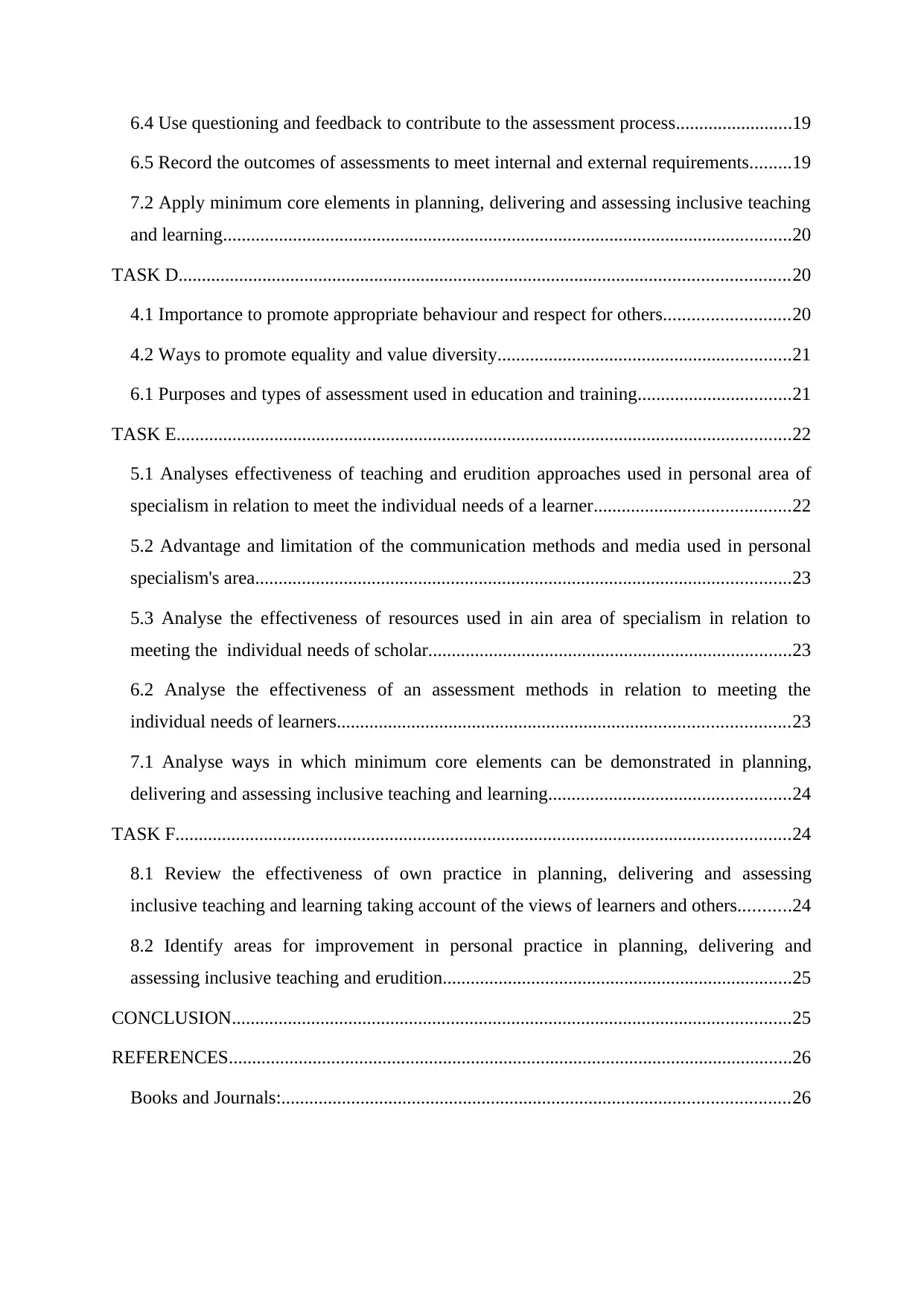
6.4 Use questioning and feedback to contribute to the assessment process.........................19
6.5 Record the outcomes of assessments to meet internal and external requirements.........19
7.2 Apply minimum core elements in planning, delivering and assessing inclusive teaching
and learning..........................................................................................................................20
TASK D...................................................................................................................................20
4.1 Importance to promote appropriate behaviour and respect for others...........................20
4.2 Ways to promote equality and value diversity...............................................................21
6.1 Purposes and types of assessment used in education and training.................................21
TASK E....................................................................................................................................22
5.1 Analyses effectiveness of teaching and erudition approaches used in personal area of
specialism in relation to meet the individual needs of a learner..........................................22
5.2 Advantage and limitation of the communication methods and media used in personal
specialism's area...................................................................................................................23
5.3 Analyse the effectiveness of resources used in ain area of specialism in relation to
meeting the individual needs of scholar..............................................................................23
6.2 Analyse the effectiveness of an assessment methods in relation to meeting the
individual needs of learners.................................................................................................23
7.1 Analyse ways in which minimum core elements can be demonstrated in planning,
delivering and assessing inclusive teaching and learning....................................................24
TASK F....................................................................................................................................24
8.1 Review the effectiveness of own practice in planning, delivering and assessing
inclusive teaching and learning taking account of the views of learners and others...........24
8.2 Identify areas for improvement in personal practice in planning, delivering and
assessing inclusive teaching and erudition...........................................................................25
CONCLUSION........................................................................................................................25
REFERENCES.........................................................................................................................26
Books and Journals:.............................................................................................................26
6.5 Record the outcomes of assessments to meet internal and external requirements.........19
7.2 Apply minimum core elements in planning, delivering and assessing inclusive teaching
and learning..........................................................................................................................20
TASK D...................................................................................................................................20
4.1 Importance to promote appropriate behaviour and respect for others...........................20
4.2 Ways to promote equality and value diversity...............................................................21
6.1 Purposes and types of assessment used in education and training.................................21
TASK E....................................................................................................................................22
5.1 Analyses effectiveness of teaching and erudition approaches used in personal area of
specialism in relation to meet the individual needs of a learner..........................................22
5.2 Advantage and limitation of the communication methods and media used in personal
specialism's area...................................................................................................................23
5.3 Analyse the effectiveness of resources used in ain area of specialism in relation to
meeting the individual needs of scholar..............................................................................23
6.2 Analyse the effectiveness of an assessment methods in relation to meeting the
individual needs of learners.................................................................................................23
7.1 Analyse ways in which minimum core elements can be demonstrated in planning,
delivering and assessing inclusive teaching and learning....................................................24
TASK F....................................................................................................................................24
8.1 Review the effectiveness of own practice in planning, delivering and assessing
inclusive teaching and learning taking account of the views of learners and others...........24
8.2 Identify areas for improvement in personal practice in planning, delivering and
assessing inclusive teaching and erudition...........................................................................25
CONCLUSION........................................................................................................................25
REFERENCES.........................................................................................................................26
Books and Journals:.............................................................................................................26
⊘ This is a preview!⊘
Do you want full access?
Subscribe today to unlock all pages.

Trusted by 1+ million students worldwide
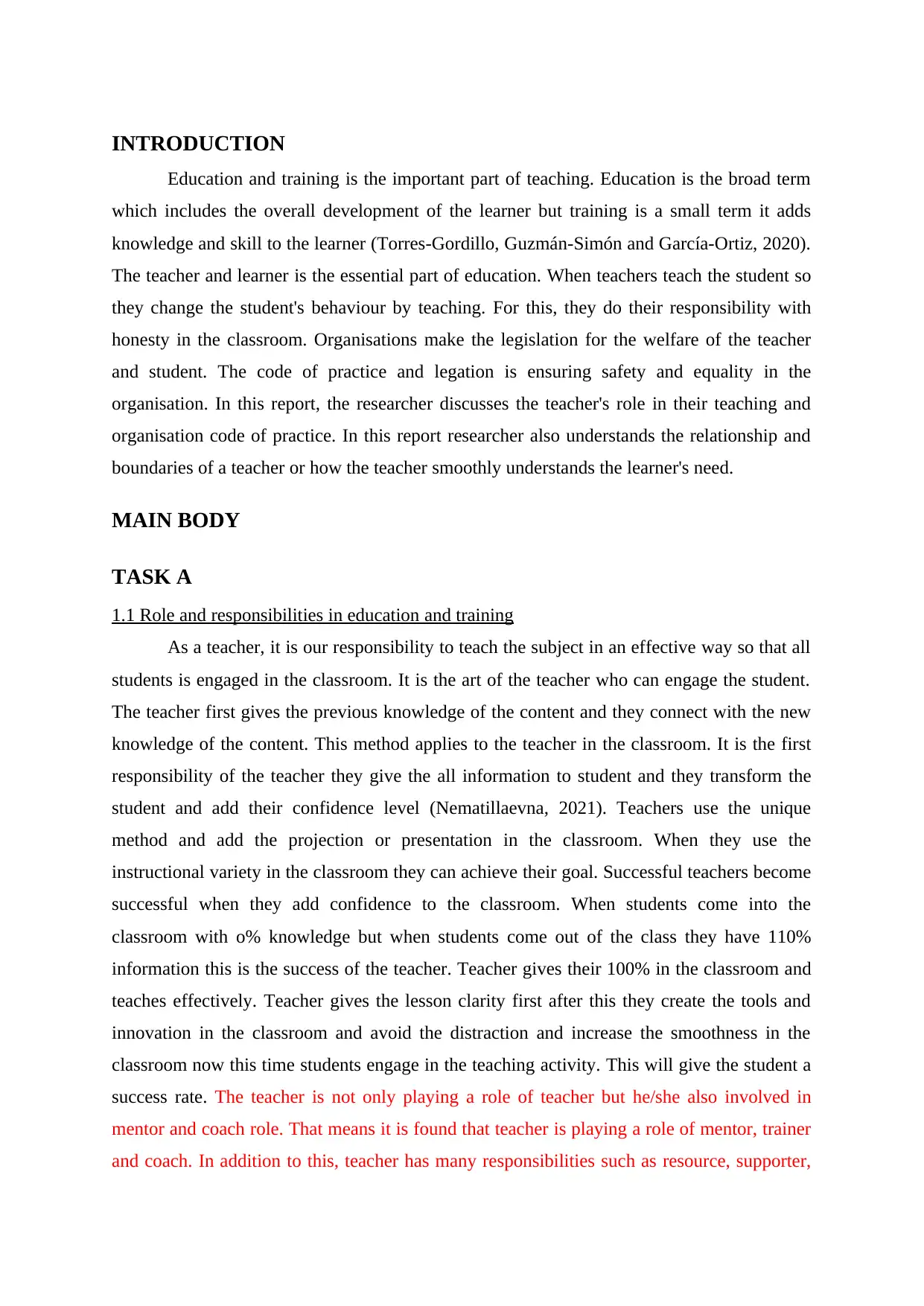
INTRODUCTION
Education and training is the important part of teaching. Education is the broad term
which includes the overall development of the learner but training is a small term it adds
knowledge and skill to the learner (Torres-Gordillo, Guzmán-Simón and García-Ortiz, 2020).
The teacher and learner is the essential part of education. When teachers teach the student so
they change the student's behaviour by teaching. For this, they do their responsibility with
honesty in the classroom. Organisations make the legislation for the welfare of the teacher
and student. The code of practice and legation is ensuring safety and equality in the
organisation. In this report, the researcher discusses the teacher's role in their teaching and
organisation code of practice. In this report researcher also understands the relationship and
boundaries of a teacher or how the teacher smoothly understands the learner's need.
MAIN BODY
TASK A
1.1 Role and responsibilities in education and training
As a teacher, it is our responsibility to teach the subject in an effective way so that all
students is engaged in the classroom. It is the art of the teacher who can engage the student.
The teacher first gives the previous knowledge of the content and they connect with the new
knowledge of the content. This method applies to the teacher in the classroom. It is the first
responsibility of the teacher they give the all information to student and they transform the
student and add their confidence level (Nematillaevna, 2021). Teachers use the unique
method and add the projection or presentation in the classroom. When they use the
instructional variety in the classroom they can achieve their goal. Successful teachers become
successful when they add confidence to the classroom. When students come into the
classroom with o% knowledge but when students come out of the class they have 110%
information this is the success of the teacher. Teacher gives their 100% in the classroom and
teaches effectively. Teacher gives the lesson clarity first after this they create the tools and
innovation in the classroom and avoid the distraction and increase the smoothness in the
classroom now this time students engage in the teaching activity. This will give the student a
success rate. The teacher is not only playing a role of teacher but he/she also involved in
mentor and coach role. That means it is found that teacher is playing a role of mentor, trainer
and coach. In addition to this, teacher has many responsibilities such as resource, supporter,
Education and training is the important part of teaching. Education is the broad term
which includes the overall development of the learner but training is a small term it adds
knowledge and skill to the learner (Torres-Gordillo, Guzmán-Simón and García-Ortiz, 2020).
The teacher and learner is the essential part of education. When teachers teach the student so
they change the student's behaviour by teaching. For this, they do their responsibility with
honesty in the classroom. Organisations make the legislation for the welfare of the teacher
and student. The code of practice and legation is ensuring safety and equality in the
organisation. In this report, the researcher discusses the teacher's role in their teaching and
organisation code of practice. In this report researcher also understands the relationship and
boundaries of a teacher or how the teacher smoothly understands the learner's need.
MAIN BODY
TASK A
1.1 Role and responsibilities in education and training
As a teacher, it is our responsibility to teach the subject in an effective way so that all
students is engaged in the classroom. It is the art of the teacher who can engage the student.
The teacher first gives the previous knowledge of the content and they connect with the new
knowledge of the content. This method applies to the teacher in the classroom. It is the first
responsibility of the teacher they give the all information to student and they transform the
student and add their confidence level (Nematillaevna, 2021). Teachers use the unique
method and add the projection or presentation in the classroom. When they use the
instructional variety in the classroom they can achieve their goal. Successful teachers become
successful when they add confidence to the classroom. When students come into the
classroom with o% knowledge but when students come out of the class they have 110%
information this is the success of the teacher. Teacher gives their 100% in the classroom and
teaches effectively. Teacher gives the lesson clarity first after this they create the tools and
innovation in the classroom and avoid the distraction and increase the smoothness in the
classroom now this time students engage in the teaching activity. This will give the student a
success rate. The teacher is not only playing a role of teacher but he/she also involved in
mentor and coach role. That means it is found that teacher is playing a role of mentor, trainer
and coach. In addition to this, teacher has many responsibilities such as resource, supporter,
Paraphrase This Document
Need a fresh take? Get an instant paraphrase of this document with our AI Paraphraser
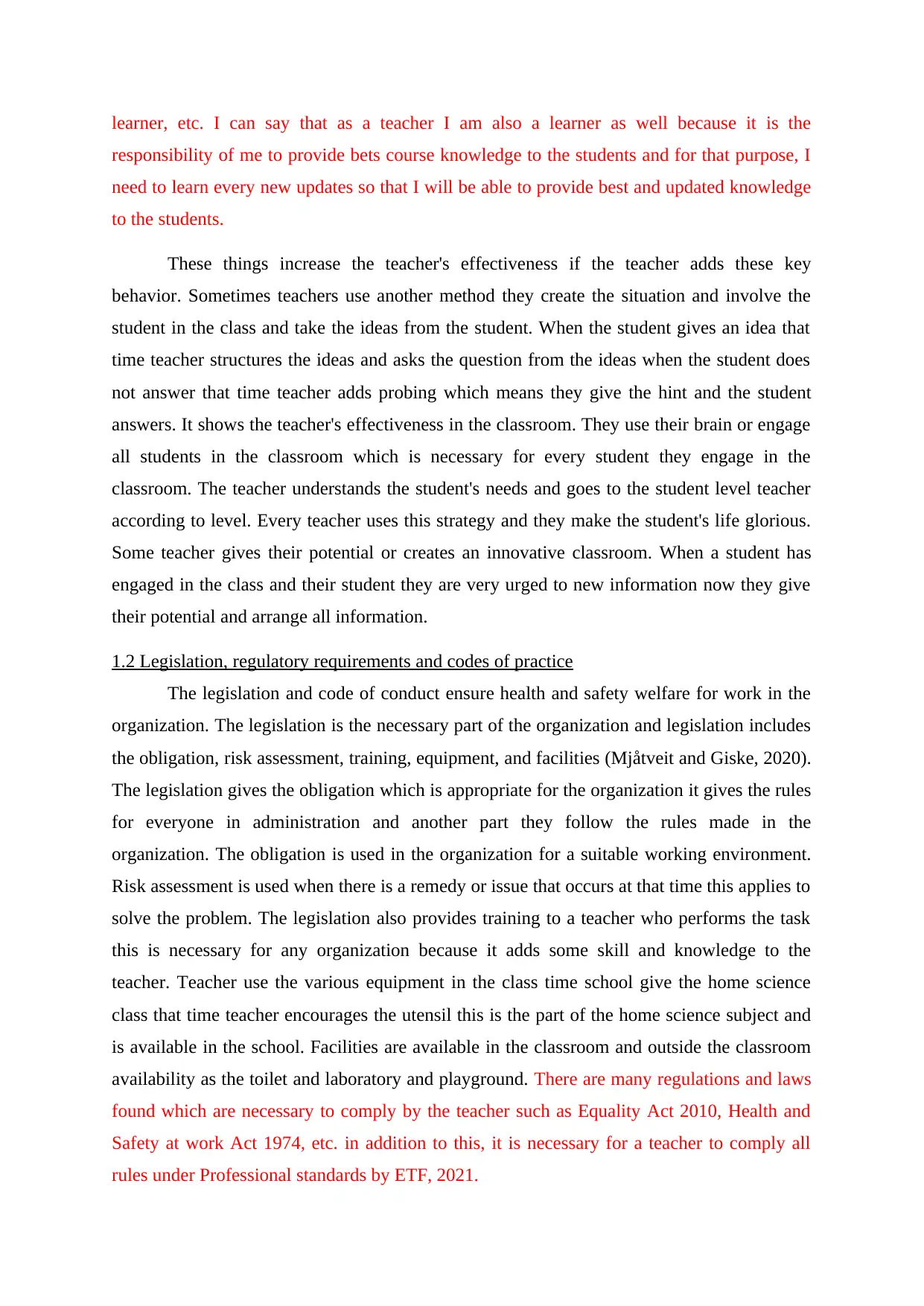
learner, etc. I can say that as a teacher I am also a learner as well because it is the
responsibility of me to provide bets course knowledge to the students and for that purpose, I
need to learn every new updates so that I will be able to provide best and updated knowledge
to the students.
These things increase the teacher's effectiveness if the teacher adds these key
behavior. Sometimes teachers use another method they create the situation and involve the
student in the class and take the ideas from the student. When the student gives an idea that
time teacher structures the ideas and asks the question from the ideas when the student does
not answer that time teacher adds probing which means they give the hint and the student
answers. It shows the teacher's effectiveness in the classroom. They use their brain or engage
all students in the classroom which is necessary for every student they engage in the
classroom. The teacher understands the student's needs and goes to the student level teacher
according to level. Every teacher uses this strategy and they make the student's life glorious.
Some teacher gives their potential or creates an innovative classroom. When a student has
engaged in the class and their student they are very urged to new information now they give
their potential and arrange all information.
1.2 Legislation, regulatory requirements and codes of practice
The legislation and code of conduct ensure health and safety welfare for work in the
organization. The legislation is the necessary part of the organization and legislation includes
the obligation, risk assessment, training, equipment, and facilities (Mjåtveit and Giske, 2020).
The legislation gives the obligation which is appropriate for the organization it gives the rules
for everyone in administration and another part they follow the rules made in the
organization. The obligation is used in the organization for a suitable working environment.
Risk assessment is used when there is a remedy or issue that occurs at that time this applies to
solve the problem. The legislation also provides training to a teacher who performs the task
this is necessary for any organization because it adds some skill and knowledge to the
teacher. Teacher use the various equipment in the class time school give the home science
class that time teacher encourages the utensil this is the part of the home science subject and
is available in the school. Facilities are available in the classroom and outside the classroom
availability as the toilet and laboratory and playground. There are many regulations and laws
found which are necessary to comply by the teacher such as Equality Act 2010, Health and
Safety at work Act 1974, etc. in addition to this, it is necessary for a teacher to comply all
rules under Professional standards by ETF, 2021.
responsibility of me to provide bets course knowledge to the students and for that purpose, I
need to learn every new updates so that I will be able to provide best and updated knowledge
to the students.
These things increase the teacher's effectiveness if the teacher adds these key
behavior. Sometimes teachers use another method they create the situation and involve the
student in the class and take the ideas from the student. When the student gives an idea that
time teacher structures the ideas and asks the question from the ideas when the student does
not answer that time teacher adds probing which means they give the hint and the student
answers. It shows the teacher's effectiveness in the classroom. They use their brain or engage
all students in the classroom which is necessary for every student they engage in the
classroom. The teacher understands the student's needs and goes to the student level teacher
according to level. Every teacher uses this strategy and they make the student's life glorious.
Some teacher gives their potential or creates an innovative classroom. When a student has
engaged in the class and their student they are very urged to new information now they give
their potential and arrange all information.
1.2 Legislation, regulatory requirements and codes of practice
The legislation and code of conduct ensure health and safety welfare for work in the
organization. The legislation is the necessary part of the organization and legislation includes
the obligation, risk assessment, training, equipment, and facilities (Mjåtveit and Giske, 2020).
The legislation gives the obligation which is appropriate for the organization it gives the rules
for everyone in administration and another part they follow the rules made in the
organization. The obligation is used in the organization for a suitable working environment.
Risk assessment is used when there is a remedy or issue that occurs at that time this applies to
solve the problem. The legislation also provides training to a teacher who performs the task
this is necessary for any organization because it adds some skill and knowledge to the
teacher. Teacher use the various equipment in the class time school give the home science
class that time teacher encourages the utensil this is the part of the home science subject and
is available in the school. Facilities are available in the classroom and outside the classroom
availability as the toilet and laboratory and playground. There are many regulations and laws
found which are necessary to comply by the teacher such as Equality Act 2010, Health and
Safety at work Act 1974, etc. in addition to this, it is necessary for a teacher to comply all
rules under Professional standards by ETF, 2021.
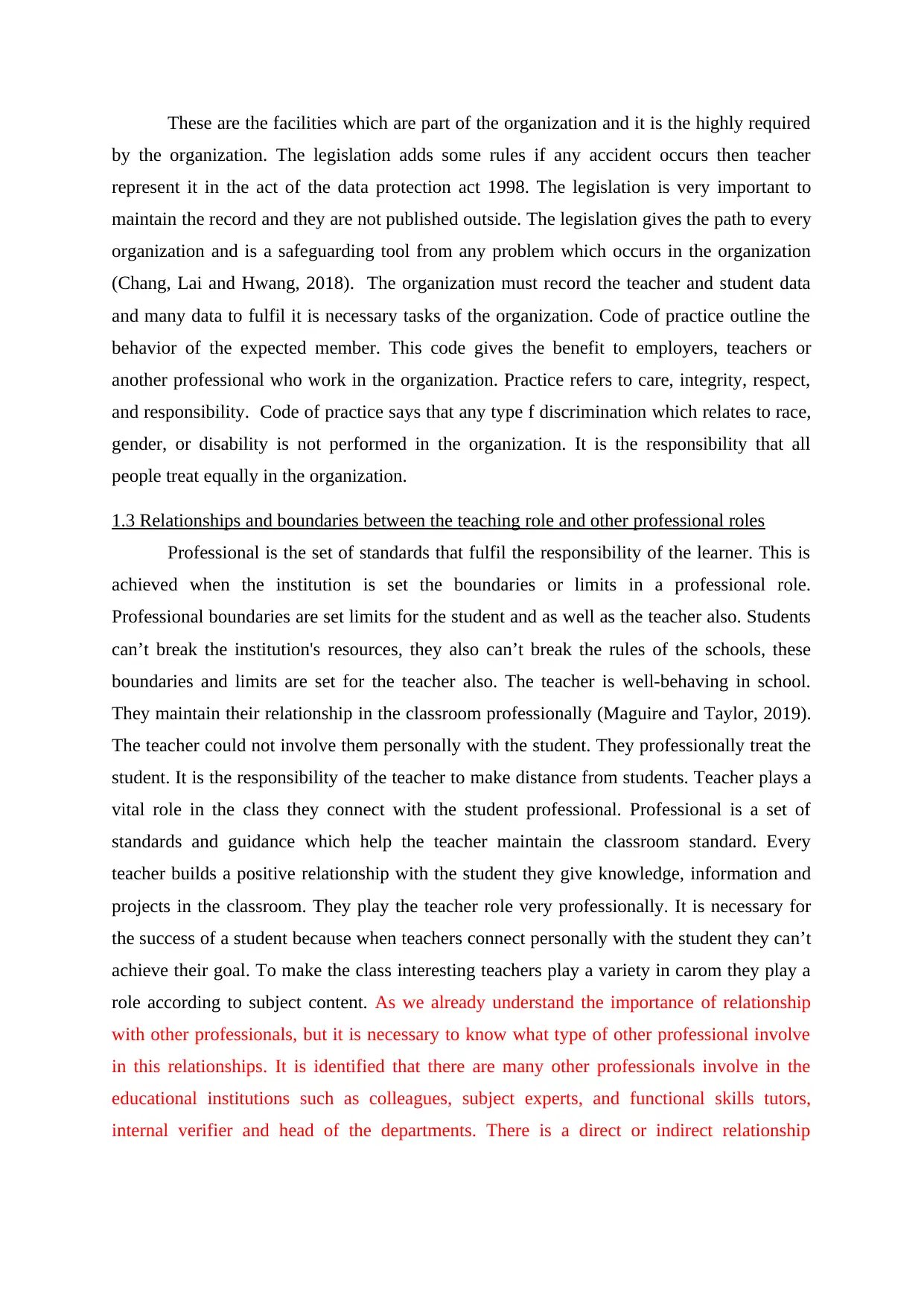
These are the facilities which are part of the organization and it is the highly required
by the organization. The legislation adds some rules if any accident occurs then teacher
represent it in the act of the data protection act 1998. The legislation is very important to
maintain the record and they are not published outside. The legislation gives the path to every
organization and is a safeguarding tool from any problem which occurs in the organization
(Chang, Lai and Hwang, 2018). The organization must record the teacher and student data
and many data to fulfil it is necessary tasks of the organization. Code of practice outline the
behavior of the expected member. This code gives the benefit to employers, teachers or
another professional who work in the organization. Practice refers to care, integrity, respect,
and responsibility. Code of practice says that any type f discrimination which relates to race,
gender, or disability is not performed in the organization. It is the responsibility that all
people treat equally in the organization.
1.3 Relationships and boundaries between the teaching role and other professional roles
Professional is the set of standards that fulfil the responsibility of the learner. This is
achieved when the institution is set the boundaries or limits in a professional role.
Professional boundaries are set limits for the student and as well as the teacher also. Students
can’t break the institution's resources, they also can’t break the rules of the schools, these
boundaries and limits are set for the teacher also. The teacher is well-behaving in school.
They maintain their relationship in the classroom professionally (Maguire and Taylor, 2019).
The teacher could not involve them personally with the student. They professionally treat the
student. It is the responsibility of the teacher to make distance from students. Teacher plays a
vital role in the class they connect with the student professional. Professional is a set of
standards and guidance which help the teacher maintain the classroom standard. Every
teacher builds a positive relationship with the student they give knowledge, information and
projects in the classroom. They play the teacher role very professionally. It is necessary for
the success of a student because when teachers connect personally with the student they can’t
achieve their goal. To make the class interesting teachers play a variety in carom they play a
role according to subject content. As we already understand the importance of relationship
with other professionals, but it is necessary to know what type of other professional involve
in this relationships. It is identified that there are many other professionals involve in the
educational institutions such as colleagues, subject experts, and functional skills tutors,
internal verifier and head of the departments. There is a direct or indirect relationship
by the organization. The legislation adds some rules if any accident occurs then teacher
represent it in the act of the data protection act 1998. The legislation is very important to
maintain the record and they are not published outside. The legislation gives the path to every
organization and is a safeguarding tool from any problem which occurs in the organization
(Chang, Lai and Hwang, 2018). The organization must record the teacher and student data
and many data to fulfil it is necessary tasks of the organization. Code of practice outline the
behavior of the expected member. This code gives the benefit to employers, teachers or
another professional who work in the organization. Practice refers to care, integrity, respect,
and responsibility. Code of practice says that any type f discrimination which relates to race,
gender, or disability is not performed in the organization. It is the responsibility that all
people treat equally in the organization.
1.3 Relationships and boundaries between the teaching role and other professional roles
Professional is the set of standards that fulfil the responsibility of the learner. This is
achieved when the institution is set the boundaries or limits in a professional role.
Professional boundaries are set limits for the student and as well as the teacher also. Students
can’t break the institution's resources, they also can’t break the rules of the schools, these
boundaries and limits are set for the teacher also. The teacher is well-behaving in school.
They maintain their relationship in the classroom professionally (Maguire and Taylor, 2019).
The teacher could not involve them personally with the student. They professionally treat the
student. It is the responsibility of the teacher to make distance from students. Teacher plays a
vital role in the class they connect with the student professional. Professional is a set of
standards and guidance which help the teacher maintain the classroom standard. Every
teacher builds a positive relationship with the student they give knowledge, information and
projects in the classroom. They play the teacher role very professionally. It is necessary for
the success of a student because when teachers connect personally with the student they can’t
achieve their goal. To make the class interesting teachers play a variety in carom they play a
role according to subject content. As we already understand the importance of relationship
with other professionals, but it is necessary to know what type of other professional involve
in this relationships. It is identified that there are many other professionals involve in the
educational institutions such as colleagues, subject experts, and functional skills tutors,
internal verifier and head of the departments. There is a direct or indirect relationship
⊘ This is a preview!⊘
Do you want full access?
Subscribe today to unlock all pages.

Trusted by 1+ million students worldwide
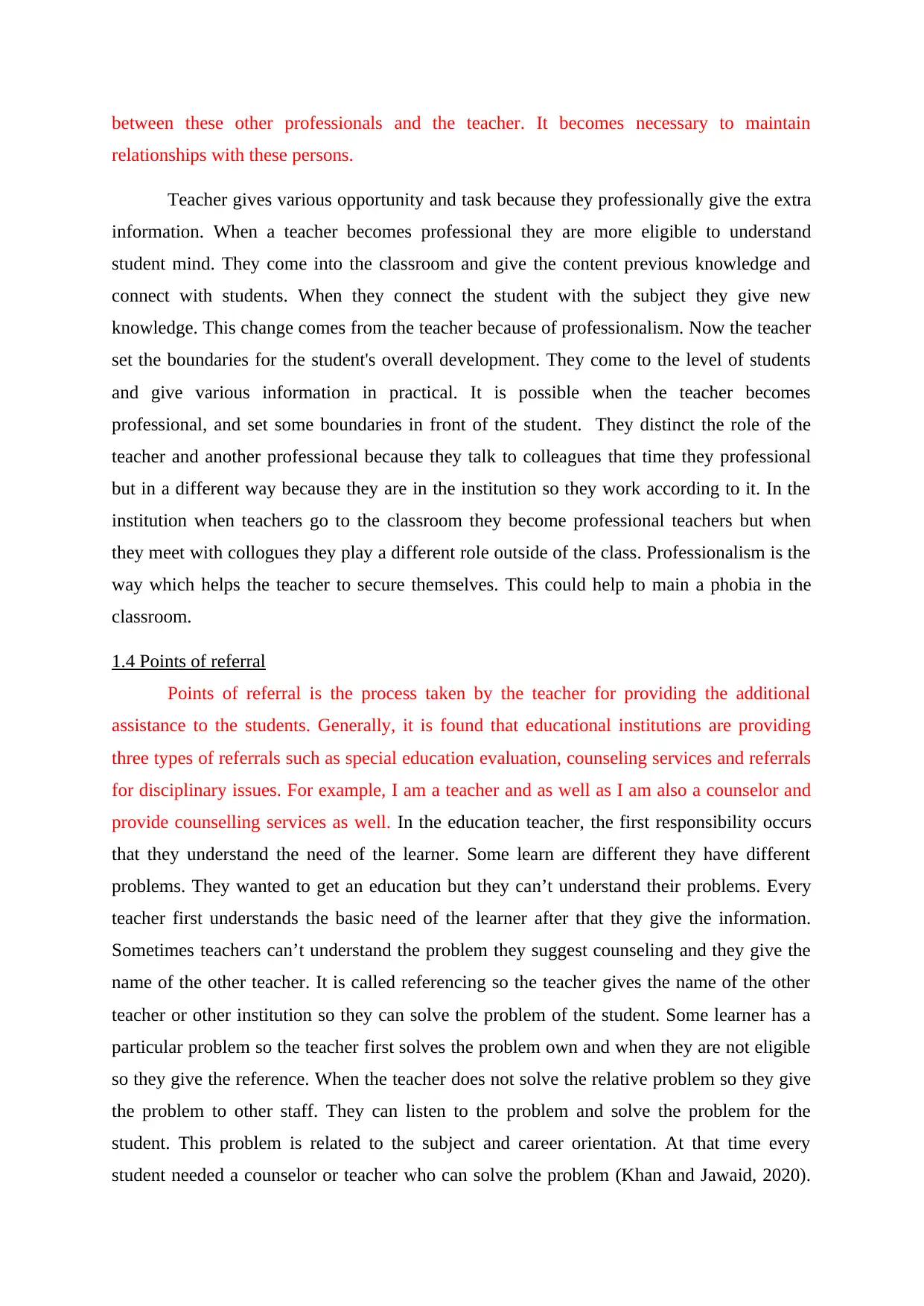
between these other professionals and the teacher. It becomes necessary to maintain
relationships with these persons.
Teacher gives various opportunity and task because they professionally give the extra
information. When a teacher becomes professional they are more eligible to understand
student mind. They come into the classroom and give the content previous knowledge and
connect with students. When they connect the student with the subject they give new
knowledge. This change comes from the teacher because of professionalism. Now the teacher
set the boundaries for the student's overall development. They come to the level of students
and give various information in practical. It is possible when the teacher becomes
professional, and set some boundaries in front of the student. They distinct the role of the
teacher and another professional because they talk to colleagues that time they professional
but in a different way because they are in the institution so they work according to it. In the
institution when teachers go to the classroom they become professional teachers but when
they meet with collogues they play a different role outside of the class. Professionalism is the
way which helps the teacher to secure themselves. This could help to main a phobia in the
classroom.
1.4 Points of referral
Points of referral is the process taken by the teacher for providing the additional
assistance to the students. Generally, it is found that educational institutions are providing
three types of referrals such as special education evaluation, counseling services and referrals
for disciplinary issues. For example, I am a teacher and as well as I am also a counselor and
provide counselling services as well. In the education teacher, the first responsibility occurs
that they understand the need of the learner. Some learn are different they have different
problems. They wanted to get an education but they can’t understand their problems. Every
teacher first understands the basic need of the learner after that they give the information.
Sometimes teachers can’t understand the problem they suggest counseling and they give the
name of the other teacher. It is called referencing so the teacher gives the name of the other
teacher or other institution so they can solve the problem of the student. Some learner has a
particular problem so the teacher first solves the problem own and when they are not eligible
so they give the reference. When the teacher does not solve the relative problem so they give
the problem to other staff. They can listen to the problem and solve the problem for the
student. This problem is related to the subject and career orientation. At that time every
student needed a counselor or teacher who can solve the problem (Khan and Jawaid, 2020).
relationships with these persons.
Teacher gives various opportunity and task because they professionally give the extra
information. When a teacher becomes professional they are more eligible to understand
student mind. They come into the classroom and give the content previous knowledge and
connect with students. When they connect the student with the subject they give new
knowledge. This change comes from the teacher because of professionalism. Now the teacher
set the boundaries for the student's overall development. They come to the level of students
and give various information in practical. It is possible when the teacher becomes
professional, and set some boundaries in front of the student. They distinct the role of the
teacher and another professional because they talk to colleagues that time they professional
but in a different way because they are in the institution so they work according to it. In the
institution when teachers go to the classroom they become professional teachers but when
they meet with collogues they play a different role outside of the class. Professionalism is the
way which helps the teacher to secure themselves. This could help to main a phobia in the
classroom.
1.4 Points of referral
Points of referral is the process taken by the teacher for providing the additional
assistance to the students. Generally, it is found that educational institutions are providing
three types of referrals such as special education evaluation, counseling services and referrals
for disciplinary issues. For example, I am a teacher and as well as I am also a counselor and
provide counselling services as well. In the education teacher, the first responsibility occurs
that they understand the need of the learner. Some learn are different they have different
problems. They wanted to get an education but they can’t understand their problems. Every
teacher first understands the basic need of the learner after that they give the information.
Sometimes teachers can’t understand the problem they suggest counseling and they give the
name of the other teacher. It is called referencing so the teacher gives the name of the other
teacher or other institution so they can solve the problem of the student. Some learner has a
particular problem so the teacher first solves the problem own and when they are not eligible
so they give the reference. When the teacher does not solve the relative problem so they give
the problem to other staff. They can listen to the problem and solve the problem for the
student. This problem is related to the subject and career orientation. At that time every
student needed a counselor or teacher who can solve the problem (Khan and Jawaid, 2020).
Paraphrase This Document
Need a fresh take? Get an instant paraphrase of this document with our AI Paraphraser

These are very necessary for the teacher to listen to the problem because when students phase
problems they go with mental trauma so as a teacher it is the responsibility of every teacher
to understand the student's needs. In the organization, specialist staffs are available who can
solve the problem so the teacher suggests the student go for the specialist. A student phase
the problem of bullying behavior and sometimes they do not understand the specific teacher
subject so they do not tell the teacher but the teacher understands the student's problem and
gives advice.
Now these days, these types of problems are seen in schools. so the school make a
committee that can solve these problems. These are necessary for the organization's
development they make the commitment to the development of the organization and solve the
problem in the classroom. This committee is consisting the specialist officer who can solve
the student's problem and they keep their eye on the teacher and all over the organization.
When they saw this type of problem they go to solve the problem. These types of committees
solve any problem which occurs in the organization (Santosa and Dwi, 2019). Teachers must
understand the student's needs and what they demand in the student now every student knows
about mobile and any technical equipment. So the teacher interacts with technology and
teacher as per the student's demand. These are very necessary for a teacher to understand the
student's mindset.
Table1
Internal points of referral External points of referral
First aiders
Specialist colleagues
Language interpreters
Health centres
Carers
Charities
Relevant websites
Police
Relevant agencies such as drugs,
debt, alcohol, etc.
From the above part, it is analysed that the teacher is not only responsible for teach to
the students as there are many responsibilities which need to play by the teacher such as a
coach, mentor, trainer, etc. In addition to this, it is also analysed that the teacher should focus
on compliance of all laws. That means it is necessary for the teacher to provide an effective
problems they go with mental trauma so as a teacher it is the responsibility of every teacher
to understand the student's needs. In the organization, specialist staffs are available who can
solve the problem so the teacher suggests the student go for the specialist. A student phase
the problem of bullying behavior and sometimes they do not understand the specific teacher
subject so they do not tell the teacher but the teacher understands the student's problem and
gives advice.
Now these days, these types of problems are seen in schools. so the school make a
committee that can solve these problems. These are necessary for the organization's
development they make the commitment to the development of the organization and solve the
problem in the classroom. This committee is consisting the specialist officer who can solve
the student's problem and they keep their eye on the teacher and all over the organization.
When they saw this type of problem they go to solve the problem. These types of committees
solve any problem which occurs in the organization (Santosa and Dwi, 2019). Teachers must
understand the student's needs and what they demand in the student now every student knows
about mobile and any technical equipment. So the teacher interacts with technology and
teacher as per the student's demand. These are very necessary for a teacher to understand the
student's mindset.
Table1
Internal points of referral External points of referral
First aiders
Specialist colleagues
Language interpreters
Health centres
Carers
Charities
Relevant websites
Police
Relevant agencies such as drugs,
debt, alcohol, etc.
From the above part, it is analysed that the teacher is not only responsible for teach to
the students as there are many responsibilities which need to play by the teacher such as a
coach, mentor, trainer, etc. In addition to this, it is also analysed that the teacher should focus
on compliance of all laws. That means it is necessary for the teacher to provide an effective
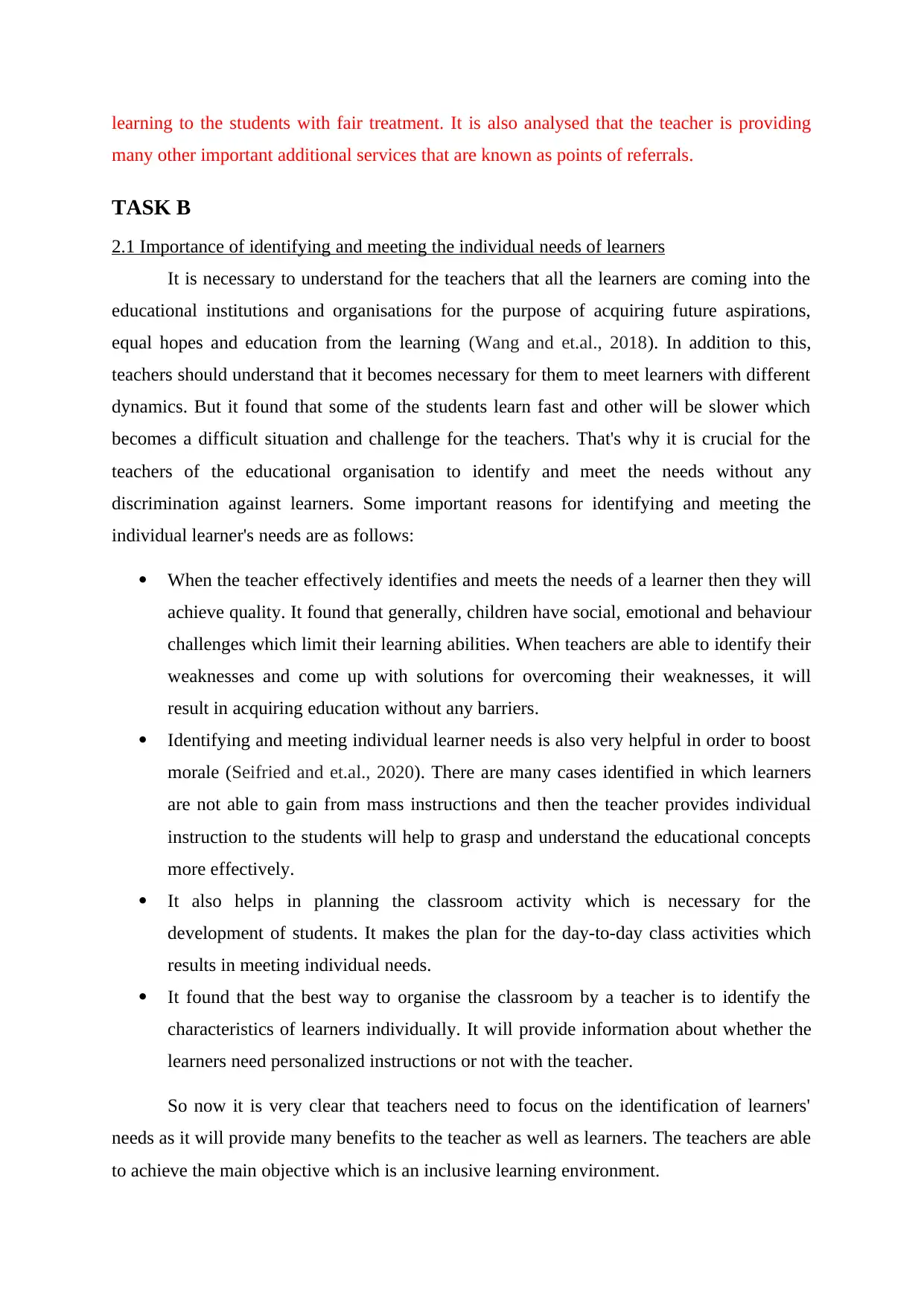
learning to the students with fair treatment. It is also analysed that the teacher is providing
many other important additional services that are known as points of referrals.
TASK B
2.1 Importance of identifying and meeting the individual needs of learners
It is necessary to understand for the teachers that all the learners are coming into the
educational institutions and organisations for the purpose of acquiring future aspirations,
equal hopes and education from the learning (Wang and et.al., 2018). In addition to this,
teachers should understand that it becomes necessary for them to meet learners with different
dynamics. But it found that some of the students learn fast and other will be slower which
becomes a difficult situation and challenge for the teachers. That's why it is crucial for the
teachers of the educational organisation to identify and meet the needs without any
discrimination against learners. Some important reasons for identifying and meeting the
individual learner's needs are as follows:
When the teacher effectively identifies and meets the needs of a learner then they will
achieve quality. It found that generally, children have social, emotional and behaviour
challenges which limit their learning abilities. When teachers are able to identify their
weaknesses and come up with solutions for overcoming their weaknesses, it will
result in acquiring education without any barriers.
Identifying and meeting individual learner needs is also very helpful in order to boost
morale (Seifried and et.al., 2020). There are many cases identified in which learners
are not able to gain from mass instructions and then the teacher provides individual
instruction to the students will help to grasp and understand the educational concepts
more effectively.
It also helps in planning the classroom activity which is necessary for the
development of students. It makes the plan for the day-to-day class activities which
results in meeting individual needs.
It found that the best way to organise the classroom by a teacher is to identify the
characteristics of learners individually. It will provide information about whether the
learners need personalized instructions or not with the teacher.
So now it is very clear that teachers need to focus on the identification of learners'
needs as it will provide many benefits to the teacher as well as learners. The teachers are able
to achieve the main objective which is an inclusive learning environment.
many other important additional services that are known as points of referrals.
TASK B
2.1 Importance of identifying and meeting the individual needs of learners
It is necessary to understand for the teachers that all the learners are coming into the
educational institutions and organisations for the purpose of acquiring future aspirations,
equal hopes and education from the learning (Wang and et.al., 2018). In addition to this,
teachers should understand that it becomes necessary for them to meet learners with different
dynamics. But it found that some of the students learn fast and other will be slower which
becomes a difficult situation and challenge for the teachers. That's why it is crucial for the
teachers of the educational organisation to identify and meet the needs without any
discrimination against learners. Some important reasons for identifying and meeting the
individual learner's needs are as follows:
When the teacher effectively identifies and meets the needs of a learner then they will
achieve quality. It found that generally, children have social, emotional and behaviour
challenges which limit their learning abilities. When teachers are able to identify their
weaknesses and come up with solutions for overcoming their weaknesses, it will
result in acquiring education without any barriers.
Identifying and meeting individual learner needs is also very helpful in order to boost
morale (Seifried and et.al., 2020). There are many cases identified in which learners
are not able to gain from mass instructions and then the teacher provides individual
instruction to the students will help to grasp and understand the educational concepts
more effectively.
It also helps in planning the classroom activity which is necessary for the
development of students. It makes the plan for the day-to-day class activities which
results in meeting individual needs.
It found that the best way to organise the classroom by a teacher is to identify the
characteristics of learners individually. It will provide information about whether the
learners need personalized instructions or not with the teacher.
So now it is very clear that teachers need to focus on the identification of learners'
needs as it will provide many benefits to the teacher as well as learners. The teachers are able
to achieve the main objective which is an inclusive learning environment.
⊘ This is a preview!⊘
Do you want full access?
Subscribe today to unlock all pages.

Trusted by 1+ million students worldwide
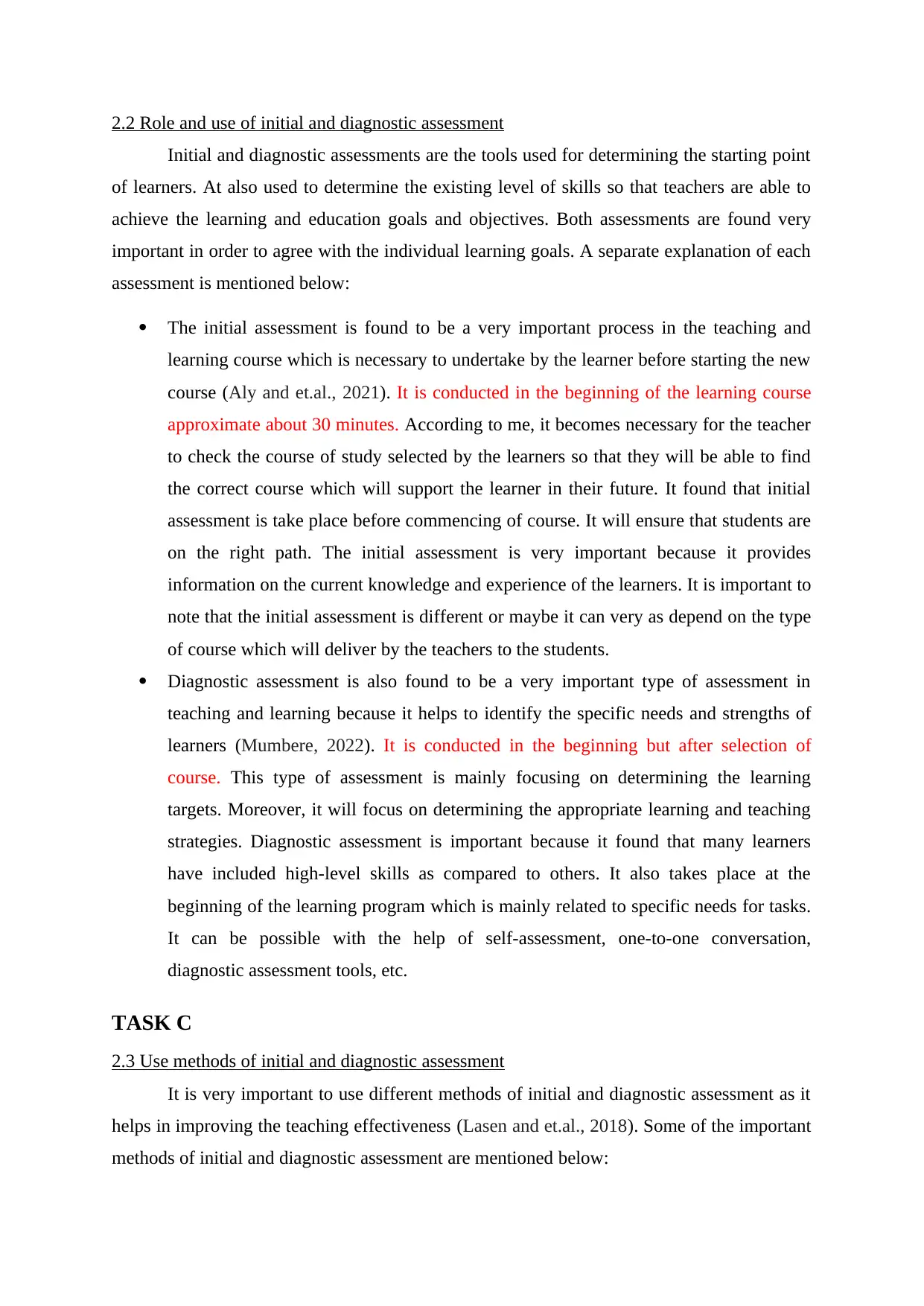
2.2 Role and use of initial and diagnostic assessment
Initial and diagnostic assessments are the tools used for determining the starting point
of learners. At also used to determine the existing level of skills so that teachers are able to
achieve the learning and education goals and objectives. Both assessments are found very
important in order to agree with the individual learning goals. A separate explanation of each
assessment is mentioned below:
The initial assessment is found to be a very important process in the teaching and
learning course which is necessary to undertake by the learner before starting the new
course (Aly and et.al., 2021). It is conducted in the beginning of the learning course
approximate about 30 minutes. According to me, it becomes necessary for the teacher
to check the course of study selected by the learners so that they will be able to find
the correct course which will support the learner in their future. It found that initial
assessment is take place before commencing of course. It will ensure that students are
on the right path. The initial assessment is very important because it provides
information on the current knowledge and experience of the learners. It is important to
note that the initial assessment is different or maybe it can very as depend on the type
of course which will deliver by the teachers to the students.
Diagnostic assessment is also found to be a very important type of assessment in
teaching and learning because it helps to identify the specific needs and strengths of
learners (Mumbere, 2022). It is conducted in the beginning but after selection of
course. This type of assessment is mainly focusing on determining the learning
targets. Moreover, it will focus on determining the appropriate learning and teaching
strategies. Diagnostic assessment is important because it found that many learners
have included high-level skills as compared to others. It also takes place at the
beginning of the learning program which is mainly related to specific needs for tasks.
It can be possible with the help of self-assessment, one-to-one conversation,
diagnostic assessment tools, etc.
TASK C
2.3 Use methods of initial and diagnostic assessment
It is very important to use different methods of initial and diagnostic assessment as it
helps in improving the teaching effectiveness (Lasen and et.al., 2018). Some of the important
methods of initial and diagnostic assessment are mentioned below:
Initial and diagnostic assessments are the tools used for determining the starting point
of learners. At also used to determine the existing level of skills so that teachers are able to
achieve the learning and education goals and objectives. Both assessments are found very
important in order to agree with the individual learning goals. A separate explanation of each
assessment is mentioned below:
The initial assessment is found to be a very important process in the teaching and
learning course which is necessary to undertake by the learner before starting the new
course (Aly and et.al., 2021). It is conducted in the beginning of the learning course
approximate about 30 minutes. According to me, it becomes necessary for the teacher
to check the course of study selected by the learners so that they will be able to find
the correct course which will support the learner in their future. It found that initial
assessment is take place before commencing of course. It will ensure that students are
on the right path. The initial assessment is very important because it provides
information on the current knowledge and experience of the learners. It is important to
note that the initial assessment is different or maybe it can very as depend on the type
of course which will deliver by the teachers to the students.
Diagnostic assessment is also found to be a very important type of assessment in
teaching and learning because it helps to identify the specific needs and strengths of
learners (Mumbere, 2022). It is conducted in the beginning but after selection of
course. This type of assessment is mainly focusing on determining the learning
targets. Moreover, it will focus on determining the appropriate learning and teaching
strategies. Diagnostic assessment is important because it found that many learners
have included high-level skills as compared to others. It also takes place at the
beginning of the learning program which is mainly related to specific needs for tasks.
It can be possible with the help of self-assessment, one-to-one conversation,
diagnostic assessment tools, etc.
TASK C
2.3 Use methods of initial and diagnostic assessment
It is very important to use different methods of initial and diagnostic assessment as it
helps in improving the teaching effectiveness (Lasen and et.al., 2018). Some of the important
methods of initial and diagnostic assessment are mentioned below:
Paraphrase This Document
Need a fresh take? Get an instant paraphrase of this document with our AI Paraphraser
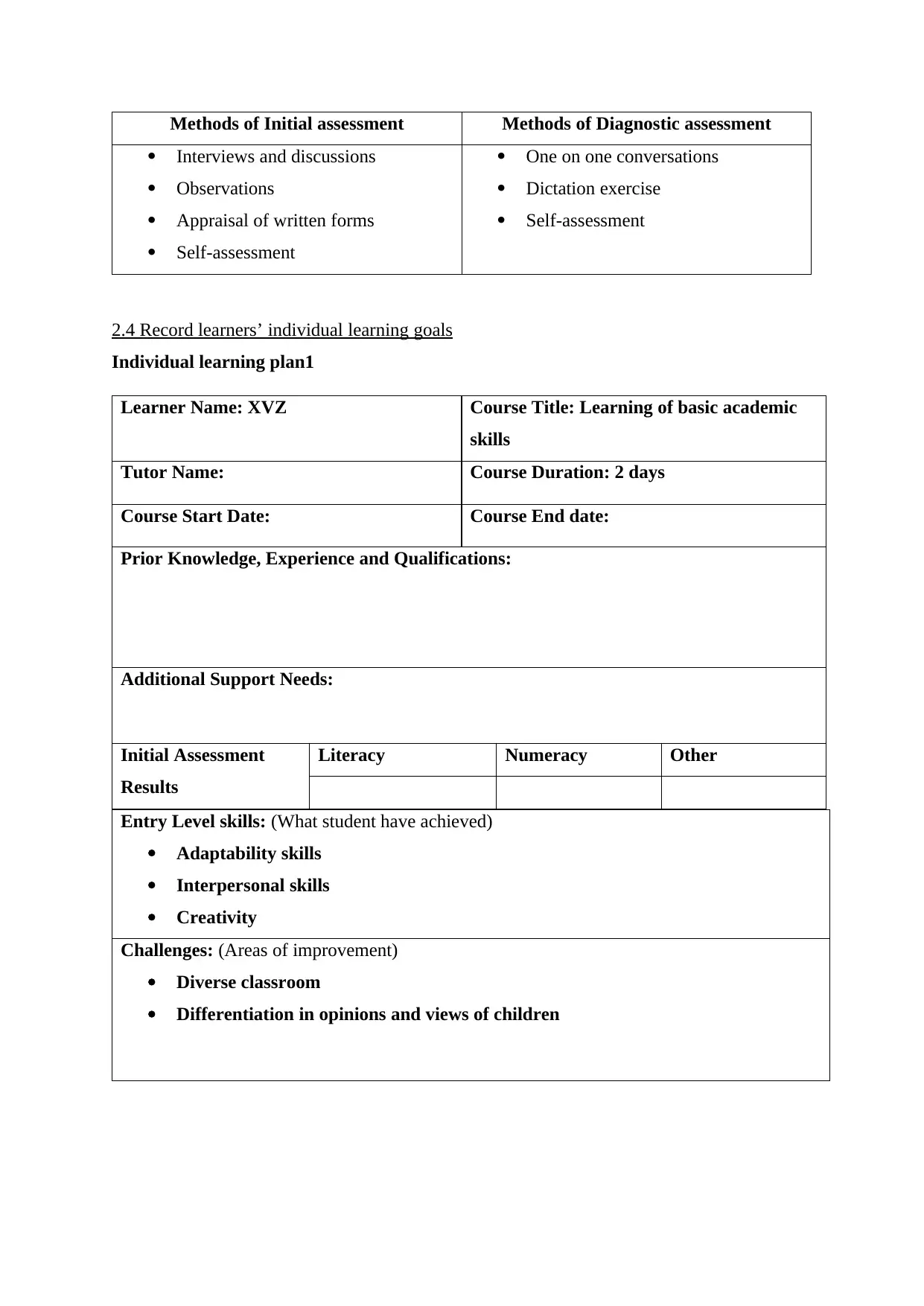
Methods of Initial assessment Methods of Diagnostic assessment
Interviews and discussions
Observations
Appraisal of written forms
Self-assessment
One on one conversations
Dictation exercise
Self-assessment
2.4 Record learners’ individual learning goals
Individual learning plan1
Learner Name: XVZ Course Title: Learning of basic academic
skills
Tutor Name: Course Duration: 2 days
Course Start Date: Course End date:
Prior Knowledge, Experience and Qualifications:
Additional Support Needs:
Initial Assessment
Results
Literacy Numeracy Other
Entry Level skills: (What student have achieved)
Adaptability skills
Interpersonal skills
Creativity
Challenges: (Areas of improvement)
Diverse classroom
Differentiation in opinions and views of children
Interviews and discussions
Observations
Appraisal of written forms
Self-assessment
One on one conversations
Dictation exercise
Self-assessment
2.4 Record learners’ individual learning goals
Individual learning plan1
Learner Name: XVZ Course Title: Learning of basic academic
skills
Tutor Name: Course Duration: 2 days
Course Start Date: Course End date:
Prior Knowledge, Experience and Qualifications:
Additional Support Needs:
Initial Assessment
Results
Literacy Numeracy Other
Entry Level skills: (What student have achieved)
Adaptability skills
Interpersonal skills
Creativity
Challenges: (Areas of improvement)
Diverse classroom
Differentiation in opinions and views of children
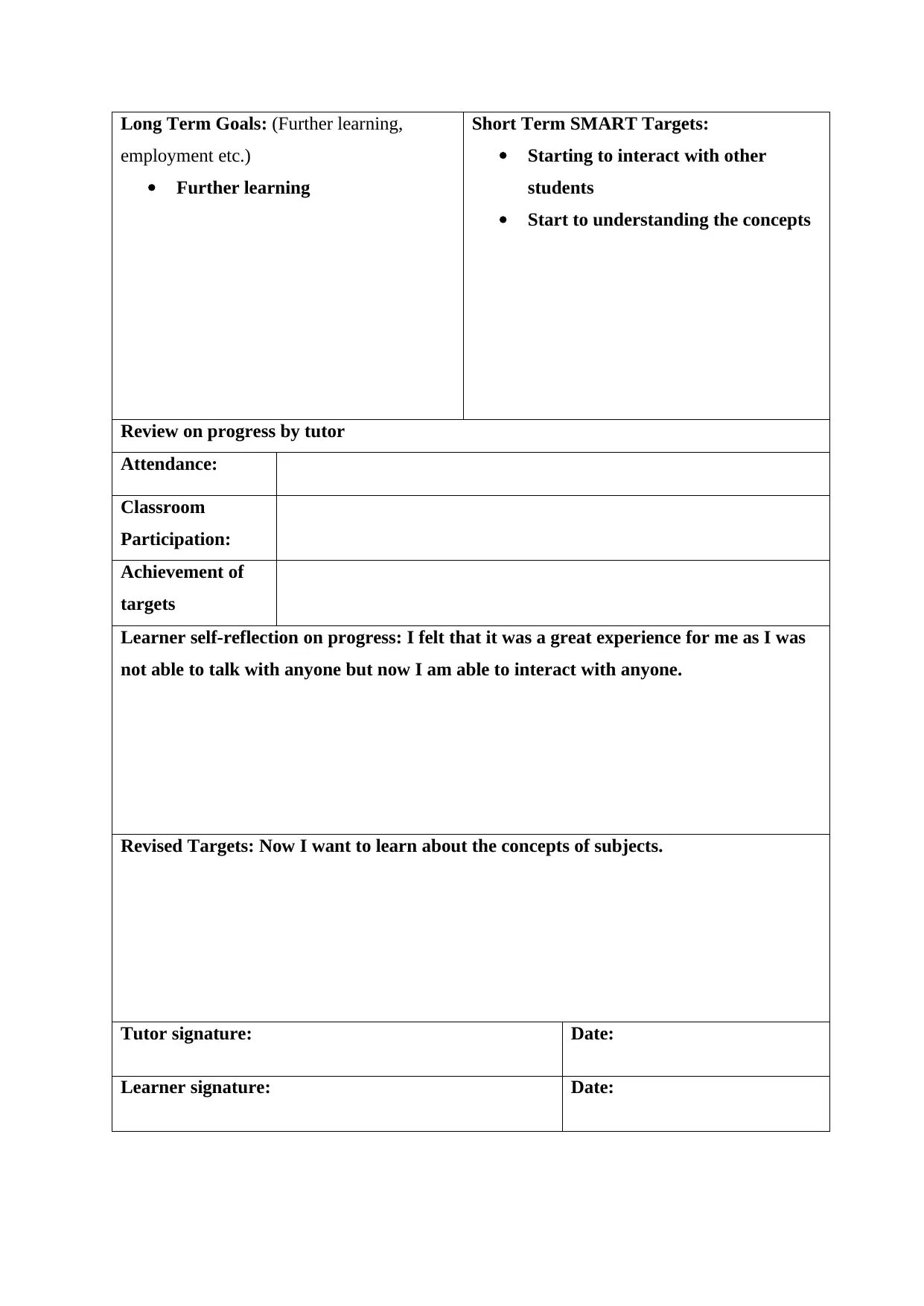
Long Term Goals: (Further learning,
employment etc.)
Further learning
Short Term SMART Targets:
Starting to interact with other
students
Start to understanding the concepts
Review on progress by tutor
Attendance:
Classroom
Participation:
Achievement of
targets
Learner self-reflection on progress: I felt that it was a great experience for me as I was
not able to talk with anyone but now I am able to interact with anyone.
Revised Targets: Now I want to learn about the concepts of subjects.
Tutor signature: Date:
Learner signature: Date:
employment etc.)
Further learning
Short Term SMART Targets:
Starting to interact with other
students
Start to understanding the concepts
Review on progress by tutor
Attendance:
Classroom
Participation:
Achievement of
targets
Learner self-reflection on progress: I felt that it was a great experience for me as I was
not able to talk with anyone but now I am able to interact with anyone.
Revised Targets: Now I want to learn about the concepts of subjects.
Tutor signature: Date:
Learner signature: Date:
⊘ This is a preview!⊘
Do you want full access?
Subscribe today to unlock all pages.

Trusted by 1+ million students worldwide
1 out of 28
Related Documents
Your All-in-One AI-Powered Toolkit for Academic Success.
+13062052269
info@desklib.com
Available 24*7 on WhatsApp / Email
![[object Object]](/_next/static/media/star-bottom.7253800d.svg)
Unlock your academic potential
Copyright © 2020–2025 A2Z Services. All Rights Reserved. Developed and managed by ZUCOL.




